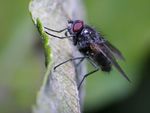Musca spp.
| This article is still under construction. |
| Musca spp. | |
|---|---|
| Kingdom | Animalia |
| Phylum | Arthropoda |
| Class | Insecta |
| Order | Diptera |
| Family | Muscidae |
| Genus | Musca |
Musca autumnalis
| Also known as: | Face Fly |
M. autumnalis is found worldwide, and is widely distributed throughout Europe.
Identification
The fly is around 7-8mm in length. It grey in colour and has 4 dark stripes on the thorax. It is very similar in appearance to M. domestica, and has prominant red eyes.
Life Cycle
M. autumnalis feeds on secretions from the nose, mouth, and the eyes, as well as blood from the wounds left by other flies. It lays eggs in cattle manure, which later develop into larvae. The larvae pass through three separate stages, before forming pupae in the soil. Under optimal conditions, they require around 2 weeks to complete the life cycle.
Musca domestica
| Also known as: | House Fly |
M. domestica is closely associated with humans and livestock. It is of importance as it mechanically transmits pathogens of real significance e.g. mastitis, and anthrax.
Identification
M. domestica is around 7mm in length, and grey in colour, with four dark longitudinal shapes. The abdomen is dark yellow in colour, with a black median stripe.
Life Cycle
The female lays eggs in faeces and dead rotting material. The eggs then hatch within a day. There are 3 subsequent larval stages and feed upon the faeces. When the larvae mature, they relocate to drier areas, where they form pupae. The pupae will then later mature into adults.
